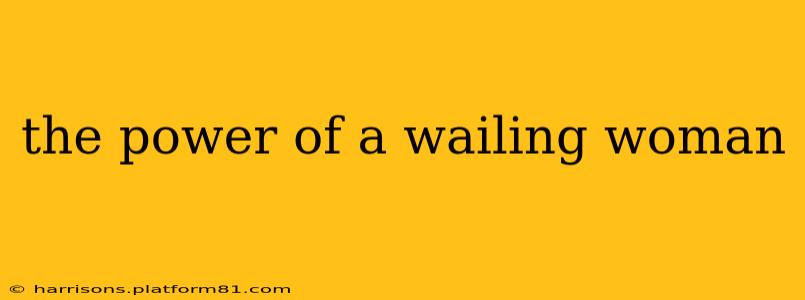The image of a wailing woman, a figure often depicted in literature, film, and across various cultures, carries a potent emotional charge. But what is the true power behind this seemingly simple act? It's far more nuanced than a mere expression of grief; wailing encompasses a complex interplay of cultural expression, emotional release, and social commentary. This exploration delves into the multifaceted significance of a wailing woman, examining its historical context, diverse interpretations, and the enduring impact of this powerful vocalization.
What does wailing signify?
Wailing, or keening as it's sometimes called, isn't simply crying; it's a stylized, often ritualistic expression of intense emotion, most commonly associated with mourning. The sounds—high-pitched cries, ululations, and rhythmic vocalizations—serve as a powerful outlet for grief, sorrow, and loss. However, its meaning transcends simple sadness. The power lies in its ability to:
- Communicate intense emotion beyond words: Wailing bypasses the limitations of language, conveying a depth of feeling that words often fail to capture. It’s a visceral expression that resonates deeply with those who hear it.
- Connect individuals to a shared experience: In many cultures, wailing is a communal act, bringing together family and community members in a shared experience of grief. This collective expression reinforces social bonds and provides comfort during times of hardship.
- Honor the deceased: Wailing often forms part of funeral rites and mourning rituals, acting as a symbolic tribute to the deceased and a way of acknowledging their passing.
- Seek spiritual solace: In some belief systems, wailing is believed to connect the mourners to the spiritual realm, facilitating communication with ancestors or spirits.
- Protest and Social Commentary: While often associated with mourning, wailing can also be a powerful tool for expressing social and political grievances. Throughout history, women have used wailing to express outrage and protest against injustice, oppression, and loss of rights.
Is wailing a sign of weakness or strength?
This is a complex question with no simple answer. While some may interpret wailing as a sign of weakness or emotional fragility, many cultures view it as a display of strength and resilience. The ability to express raw, unfiltered emotion openly requires a significant level of emotional fortitude. It's a powerful act of vulnerability that can be both cathartic and empowering. The perception of wailing as weakness or strength is heavily influenced by cultural context and individual interpretation.
What are the cultural differences in wailing?
Wailing practices vary significantly across different cultures and regions. While the core emotion remains consistent—deep sorrow and grief—the specific sounds, rituals, and social contexts surrounding wailing can be remarkably diverse. Some cultures have specific wailing songs or chants, while others emphasize spontaneous, unrestrained cries. The participation of men and women also varies significantly depending on cultural norms and traditions. For example, in some cultures, wailing is primarily a female activity, while in others, it involves both men and women. Researching the specific cultural contexts is crucial for a deeper understanding of the practice.
Why do women wail more often than men?
This observation is rooted in historical and societal factors rather than inherent biological differences. In many cultures, women have historically been assigned the primary role of emotional caregivers and mourners. Social expectations and gender roles often dictate that women express grief more openly than men, who may be pressured to suppress their emotions. However, it’s crucial to note that men do wail in many cultures, albeit often in different contexts or with different expressions.
What is the psychological impact of wailing?
The psychological benefits of wailing are significant. It serves as a powerful tool for emotional release and catharsis, allowing individuals to process their grief and trauma in a healthy way. The act of vocalizing intense emotion can help to reduce stress, alleviate anxiety, and promote a sense of emotional well-being. Further research into the therapeutic aspects of wailing is warranted to fully understand its psychological benefits.
The power of a wailing woman lies not just in the sound itself, but in the rich tapestry of cultural meaning, emotional depth, and social context it embodies. By understanding the diverse ways in which wailing is expressed and interpreted across cultures, we gain a deeper appreciation for its profound significance and enduring power.
